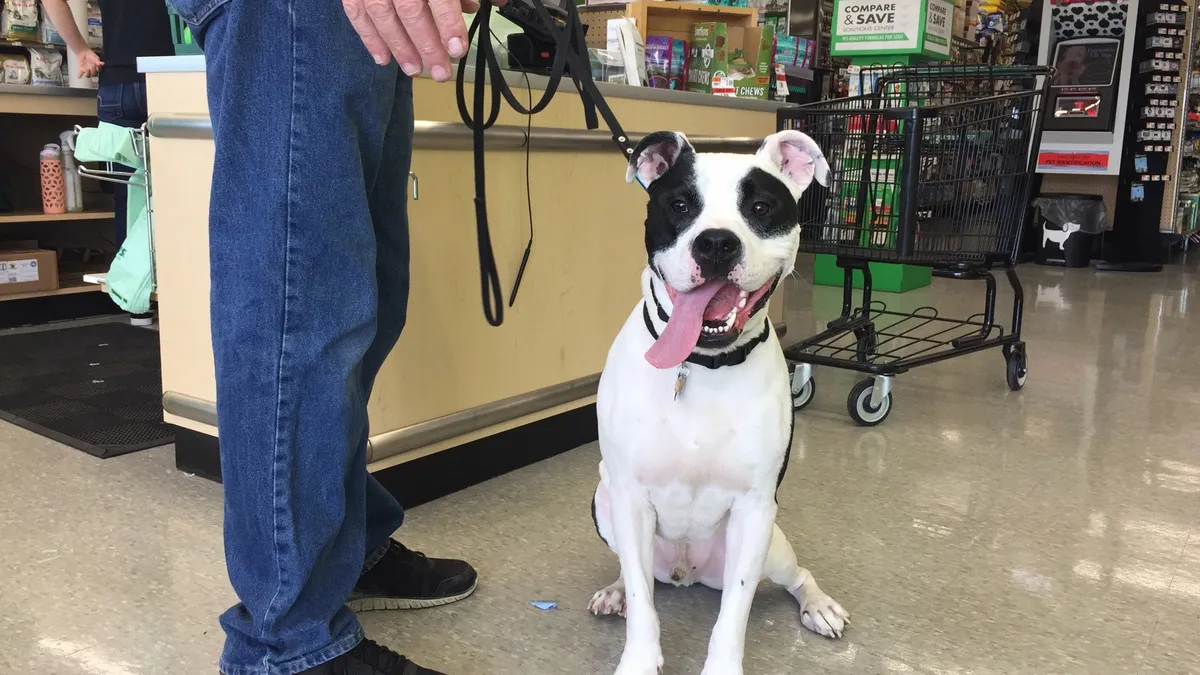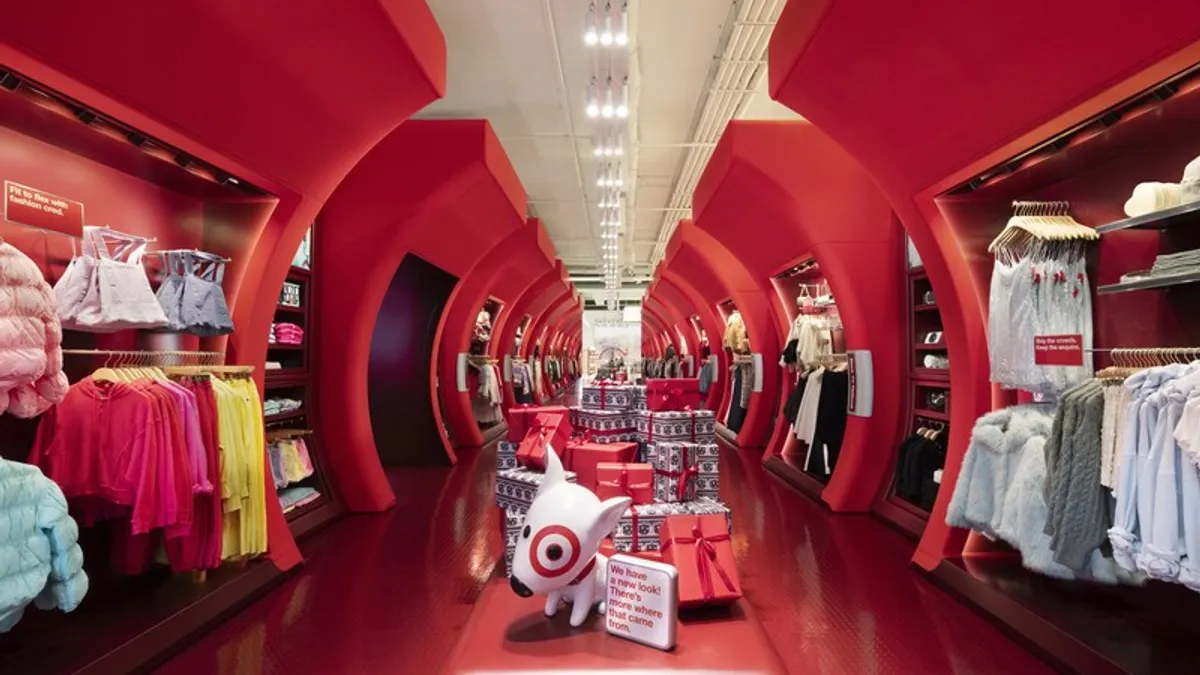When you walk into Nordstrom’s newest concept shop, there won’t be racks of blouses, skirts and slacks. In fact, if you drop in unannounced, you may not find any clothing at all. But there will be a manicure bar and a fridge full of cold pressed juice.
The 3,000 square-foot concept shop, which opened earlier this month in Los Angeles’ West Hollywood neighborhood, is focused squarely on services. From alterations and tailoring to buy online/pickup in store options and style consulting — the idea is to curate the best customer experience Nordstrom has to offer.
It’s a "neighborhood hub," as Shea Jensen, vice president of consumer experience at Nordstrom and recent director of Trunk Club, described the store to Retail Dive in an exclusive interview. "Particularly in LA, we know from our customers that driving isn't always easy and it can take a great deal of time," she said. "What we are hoping to do at Nordstrom Local is bring some of the most popular or highly demanded services closer to our customers, right there in their own neighborhood, so they can access our services and our people at a time and place that works for them."
The merchandise-free concept is a bit of an anomaly in such a margin- and transaction-driven industry. But the store isn’t meant to replace Nordstrom’s full-line stores or the off-price Rack locations. Its purpose is to complement stores by building up the company’s lifestyle branding — one of Nordstrom’s key differentiators amid fierce competition. The store is also a test bed, one that emulates the growing showroom trend touted by nimble e-commerce darlings such as Warby Parker and Bonobos.
So how does a store without merchandise operate? Retail Dive recently visited Nordstrom Local — a first of its kind for the department store retailer — to get a closer look at what could be the future of Nordstrom stores.
A 'neighborhood hub'
The idea for Nordstrom Local came about a year ago, Jensen said, and more than 140 people have collaborated to make the concept a reality. The department store retailer has had a presence in Los Angeles since the 1980s, and considering the hip, sprawling urban location, it seemed like a logical place for a neighborhood store to thrive.
Customer service and personalization are key to the success of this new store, which offers free consultations with Nordstrom and Trunk Club stylists from neighboring full-line stores.
To work with a stylist, customers can call ahead to book an appointment with specific requests — say they need help selecting new work shoes — or they can stop in for overall wardrobe inspiration. Employees are armed with tablets that allow them to help shoppers build Pinterest-like style inspiration boards with favorite looks. Before the try-on appointment the virtual pinboard can be sent to a mobile device, and the stylist can request an array of options that fit the customer’s style profile and have them delivered from a nearby Nordstrom store. Each morning, dressing rooms are outfitted with personalized picks for appointments and at the end of the day, merchandise is returned to Nordstorm stores.
The store holds eight dressing rooms, including a flexible format that can be converted to accommodate a group of friends or a husband and wife seeking wardrobe advice, for example. Shoppers can also opt to book a separate styling suite.
Male shoppers also have the option to completely customize everything from button-down shirts to chinos and suits with stylists from the company's subscription box service Trunk Club, which it acquired in 2014 and has struggled to make profitable. Down to the type of buttons, lining, stitching and measurements, the possibilities are virtually endless.
Nordstrom Local isn’t reinventing the wheel. In fact, all of the services offered here are also offered at Nordstrom stores. But customers may not have been aware of all of these services, Jensen said.
So far in the few weeks since the store opened, alterations have been an early hit — a service that is offered at all Nordstrom stores. "Imagine being on your way to work and your hem falls out of your dress or pants and we're able to get that fixed for you while you wait," Jensen said. While waiting, why not indulge in an almond milk latte or a manicure?
"We had a customer who had an online order he purchased, a sport coat. He came in and tried it on and it didn't quite fit right, so he thought ‘What a bummer, I'm going to have to return it.’ But in fact, we were able to fit it for him right there with the help of the tailor while he waited," she said.
One more reason to head into the store is to pickup online orders, a service that is increasingly becoming table stakes for retailers smoothing the divide between in-store and online shopping.
"What we aspire to do is continue to find new ways and optimize existing ways for customers to engage with our people, access our services and shop with us. Nordstorm Local is one of those ways," Jensen said. "BOPIS has been around for a few years but we're excited to offer this location pickup."
Bringing in the right customer
Right now, the store is still very much a test and there aren’t yet plans for more of its kind, Jensen said. But as the store evolves, she hopes customers will be "co-collaborators" in deciding what works and what doesn’t.
"This is our first opportunity to open a Nordstrom Local and what's most important to us now is that we invite customers to come in, participate in the services, give us great feedback and we're focused on delivering a great experience to those customers," she said.
While Jensen could not disclose metrics for success or a timeline for whether the store will expand to more locations and how it may be adapted in the future, executives will likely keep a close eye on data showing traffic, conversions as well as the relationship between the store and online interaction with the brand, according to David Bell, professor of marketing at the Wharton School of Business at the University of Pennsylvania.
"One thing they would absolutely have to do is have a data infrastructure behind this thing so they know who is coming in and what are they doing in the future, that way they can figure out the ROI of the footprint," he said.
In researching showrooms, Bell discovered a phenomenon he calls "customer supercharging," meaning a customer's perception and likeliness to engage with a brand is elevated after an in-person experience. "Our research suggests if you can get someone to come in just once that could really have a big impact on online behavior of brand in the future," Bell said. "They have to decide how to merchandise it, whether to give out espresso or champagne. What is the right experience for Nordstrom?"
"Showrooms are good for brands with emotion, touch and feel behind it. That’s the way the world is going: 9,000 stores are going to close and if [retailers] don’t take action, they could end up out of business."

David Bell
Professor of Marketing, the Wharton School of Business, the University of Pennsylvania
If brands miss the mark, it's problematic, but he's optimistic about Nordstrom's model considering its reputation for good customer service and history with store experiences.
It’s unclear yet how much the format will impact the future of Nordstrom stores, but Bell argues that showrooms are the direction the retail industry is moving in general. While that world may be dominated by e-commerce businesses for now, bigger brands like Nordstrom are smart to experiment.
"Showrooms are good for brands with emotion, touch and feel behind it," he said. "That’s the way the world is going: 9,000 stores are going to close and if [retailers] don’t take action, they could end up out of business."
A local connection is also key to getting the right type of customer in the doors, Matt Sargent, senior vice president of retail for Frank N. Magid Associates, told Retail Dive. "One of Nordstrom’s biggest headwinds is the mall location. Malls are dying and Nordstrom has succeeded despite this, not because of it," he said. "Having a local connection is important to getting traffic at its point of origin."
While Nordstrom is already immensely popular with Gen X females, Sargent said this move seems to be much more tailored to bringing in millennials. And selling experiences as opposed to things, especially on a local level, is a huge attraction for members of this generation. "If they can make more of a connection with the customer and advise on styles and brands and so forth, it gets them out of the trap of having to compete on shipping and pricing," he said.
Shoppers likely to be enticed by such a store are probably higher income earners, urban-centered people that frequent brands like J. Crew, he added. How customers in those demographics respond to the store will certainly have influence, if and when the concept expands. As the department store tests the waters, Nordstrom Local is one of a kind, but Sargent said the company may do well to push the envelope on testing.
"[T]this space is moving very quickly. Look at all the things Amazon is doing," he said. "[Retailers] need to accelerate their pace of innovation ten times. The bigger danger, not pointed at Nordstrom but apparel in general, is that we’re on the cusp of really seeing a shift over to Amazon in a big way."





















